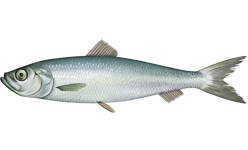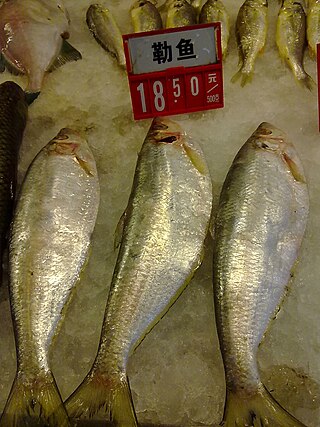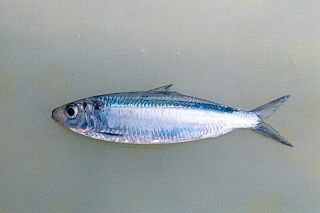
Clupeiformes is the order of ray-finned fish that includes the herring family, Clupeidae, and the anchovy family, Engraulidae. The group includes many of the most important forage and food fish.

Atlantic herring is a herring in the family Clupeidae. It is one of the most abundant fish species in the world. Atlantic herrings can be found on both sides of the Atlantic Ocean, congregating in large schools. They can grow up to 45 centimetres (18 in) in length and weigh up to 1.1 kilograms (2.4 lb). They feed on copepods, krill and small fish, while their natural predators are seals, whales, cod and other larger fish.

Alosa is a genus of fish, the river herrings, in the family Alosidae. Along with other genera in the subfamily Alosinae, they are generally known as shads. They are distinct from other herrings by having a deeper body and spawning in rivers. Several species can be found on both sides of the Atlantic Ocean and the Mediterranean Sea. Also, several taxa occur in the brackish-water Caspian Sea and the Black Sea basin. Many are found in fresh water during spawning and some are only found in landlocked fresh water.
The Argentine anchoita or Argentine anchovy is an anchovy of the genus Engraulis, found in and around waters of Argentina, Uruguay and southern Brazil.
The hickory shad, fall herring, mattowacca, freshwater taylor or bonejack is a member of the family Alosidae, ranging along the East Coast of the United States from Florida to the Gulf of Maine. It is an anadromous fish species, meaning that it spawns in freshwater portions of rivers, but spends most of its life at sea. It is subject to fishing, both historic and current, but it is often confused with or simply grouped together with American shad in catch statistics.

Alosa caspia is a species of alosid fish, one of the species of shad endemic to the Caspian Sea basin.

Etrumeus micropus is a species of round-herring that occurs in the western Pacific Ocean.

Alosa braschnikowi, the Caspian marine shad or Brazhnikov's shad, is one of the alosid fish species endemic to the Caspian Sea.

Clupea is genus of planktivorous bony fish belonging to the family Clupeidae, commonly known as herrings. They are found in the shallow, temperate waters of the North Pacific and the North Atlantic oceans, including the Baltic Sea. Two main species of Clupea are currently recognized: the Atlantic herring and the Pacific herring, which have each been divided into subspecies. Herrings are forage fish moving in vast schools, coming in spring to the shores of Europe and America, where they form important commercial fisheries.

The elongate ilisha, also known as the Chinese herring or slender shad, is a species of longfin herring native to the coastal waters and estuaries of North Indian Ocean and Northwest Pacific. It is a relatively large species, up to 45–60 centimetres (18–24 in) in total length. It is an important fishery species.

Amblygaster leiogaster, the smoothbelly sardinella, also known as blue sardine, blue sprat, bluebait, is a reef-associated marine species of sardinella in the herring family Clupeidae. It is one of the three species of genus Amblygaster. It is found in the marine waters along Indo-West Pacific regions south towards western Australia. The fish has 13 to 21 dorsal soft rays and 12 to 23 anal soft rays. It grows up to a maximum length of 23 cm. The flank is gold in fresh fish but becomes black while preservation. Belly is more rounded and scutes are not prominent. It is rather closely resemble Amblygaster clupeoides, but the latter has very few lower gill rakers than smoothbelly sardinella. The fish feeds on minute organisms like zooplankton.

Amblygaster sirm, the spotted sardinella, also known as the northern pilchard, spotted pilchard, spotted sardine, and trenched sardine, is a reef-associated marine species of sardinellas in the herring family Clupeidae.

Microthrissa royauxi, the royal sprat, is a species of pelagic, freshwater fish from the herring family Clupeidae which is found in the Congo River basin in west Africa. It was described in 1902 by the Belgian-British zoologist George Albert Boulenger. It is of limited importance as a food fish in subsistence fisheries and its conservation status is Least Concern.

Anodontostoma chacunda or Chacunda gizzard shad is a small species of gizzard shad found in both fresh and marine waters. The fish is from the family Clupeidae.
Stolephorus advenus, the false Indian anchovy, is a species of ray-finned fish in the family Engraulidae. It is found in the western-central Pacific Ocean.
Stolephorus brachycephalus, the broadhead anchovy, is a species of ray-finned fish in the family Engraulidae. It is found in the western-central Pacific Ocean.
Stolephorus dubiosus, the Thai anchovy, is a species of ray-finned fish in the family Engraulidae. It is found in the western-central Pacific Ocean.
Stolephorus multibranchus, also known as Caroline anchovy, is a species of ray-finned fish in the family Engraulidae. It is found in the western-central Pacific Ocean.
Stolephorus nelsoni, also known as Nelson's anchovy, is a species of ray-finned fish in the family Engraulidae. It is found in the eastern Indian Ocean.
Stolephorus ronquilloi, the Ronquillo's anchovy, is a species of ray-finned fish in the family Engraulidae. It is found in the western-central Pacific Ocean.











